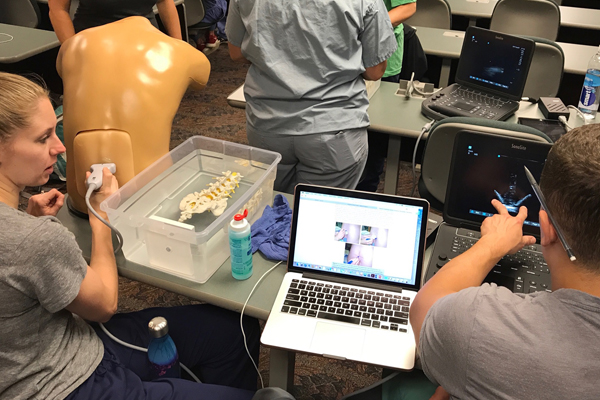A helping handbook
Nurse anesthesia students take on Anatomy Camp with the aid of a new resource
By Brelyn Powell
Regional anesthesia is a challenging field of study for those on course to become certified registered nurse anesthetists. Those administering this type of anesthesia, which is used to numb large areas of the body, require a thorough knowledge of human anatomy and physiology, and any CRNA will tell you that a textbook is no match for hands-on experience.
First-year students in the Master of Science in Nurse Anesthesia program in the Virginia Commonwealth University College of Health Professions tackle this daunting unit during Anatomy Camp.
The weeklong annual workshop takes place at the East Tennessee State University Quillen College of Medicine, with which the VCU nurse anesthesia department has maintained a partnership for more than 10 years. During the event, VCU nurse anesthesia students and ETSU medical students and interns rotate through stations to practice major regional anesthetic techniques in the school’s cadaver laboratory.
“Anatomy Camp is one of the highlights of the program,” says M.S.N.A. student Brian Widener, who attended in 2016. “It’s an immersive, intensive way to get experience that usually takes years to build – and to get that experience early.”
Nicole Damico, Ph.D. (B.S.’97/N; M.S.N.A.’99/AHP; Ph.D.’04/AHP), assistant professor and director of professional practice in the VCU Department of Nurse Anesthesia, coordinates the program each year. She says that regional anesthesia has become a more prominent part of CRNA practice in recent years.
“During their clinical training and after they graduate, they’re going to be responsible for performing these techniques on real patients, so we expect them to walk away from Anatomy Camp with a pretty solid understanding of human anatomy relevant to regional anesthesia,” she says.
Students begin preparing for Anatomy Camp weeks in advance. Before arriving on campus at ETSU, they are responsible for studying foundational material on their own – a task that Widener says can be intimidating.
“There’s just so much to cover,” he says. “Before last year’s camp, I spent days just trying to organize it in a way that made it more manageable.”
This year’s attendees benefited from the introduction of a game-changing new resource to help with that task: a pocket-size handbook of streamlined reference materials for each student to carry with them throughout the event. Lecture slides, anatomical charts, step-by-step procedural instructions and sample ultrasound images fill the book’s pages, which are laminated and easy to sanitize after use in the cadaver lab.
“They have everything you studied ahead of time but organized in a way that’s concise, efficient and accessible,” Widener says.
The new handbooks are the first benefit to come from the Elizabeth Glenn Howell Nurse Anesthesia Anatomy Camps, Workshops and Student Laboratory Fund. Created by Elizabeth Glenn Howell (M.S.N.A.’04/AHP), a former faculty member of the nurse anesthesia department, the fund serves to improve programs in the nurse anesthesia department that provide students with hands-on learning experience like Anatomy Camp. Fifty-eight handbooks were made and distributed to the VCU M.S.N.A. students.
Although Anatomy Camp did not exist when she was a student at VCU, Howell had the chance to experience it when she joined the department as an assistant professor in 2008.
“I got to see how beneficial it was for the students to work with cadavers when learning regional anesthesia,” Howell says. “Opportunities like that really help them build confidence in their abilities.”
Recognizing the importance of hands-on learning experiences for students, Howell decided to endow a fund to support that facet of their training. When she left her teaching position in 2012 to spend more time with her young children, she created the Elizabeth Glenn Howell Nurse Anesthesia Anatomy Camps, Workshops and Student Laboratory Fund with a gift of $10,000.
“The program is important to our students, so I wanted to do something to make sure it had the financial backing it needed to continue providing for them,” says Howell, who now works as a CRNA at Stony Point Surgery Center in Richmond, Virginia.
Dean of the VCU College of Health Professions Cecil B. Drain, Ph.D., R.N., C.R.N.A, F.A.A.N, says that gifts like Howell’s are among the most significant sources of funding for such programs.
“These experiences provide our students with the skills that will help them perform in their careers,” he says. “I can’t thank our alumni enough for their continued support of our programs and their investment into the success of our students.”
First-year M.S.N.A. student Michelle Jump (B.S.’14/N) says that the handbooks helped her and her classmates make the most of their time in the cadaver lab during Anatomy Camp.
“That time was ideal for digging deeper and putting the knowledge into practice, and we were able to approach the experience in a more thoughtful way,” she says.
As Jump enters her second year in the nurse anesthesia program, she is ready for whatever comes after graduation.
“I feel well-equipped because of the experiences I know I will have as a student,” she says. “I know I’m building a skill set that will help me jump into my career and do anything that’s asked of me with confidence.”
To learn more about the Department of Nurse Anesthesia in the VCU College of Health Professions, contact Heather Millar, director of development, at (804) 628-3787 or hemillar@vcu.edu.
